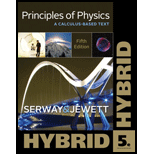
Concept explainers
(a)
Radius of the mirror.
(a)
Answer to Problem 73P
The radius should be greater than or equal to
Explanation of Solution
Write the equation for power
Here
Write the equation for area.
Here
Substitute (II) in (I) and rewrite in terms of
Conclusion:
Substitute
The radius should be greater than or equal to
(b)
Relationship between
(b)
Answer to Problem 73P
The ratio of
Explanation of Solution
Write the mirror equation
Here
Write the equation for magnification
Here
Object distance is infinite.
Then,
Rearrange (V) in terms of
Here
Write the equation for intensity of the image
Substitute
Substitute (III) and (VIII) in (X)
Conclusion:
Substitute
The ratio of
Want to see more full solutions like this?
Chapter 26 Solutions
Principles of Physics
- Electric room heaters use a concave mirror to reflect infrared (IR) radiation from hot coils. Note that IR radiation follows the same law of reflection as visible light. Given that the mirror has a radius of curvature of 50.0 cm and produces an image of the coils 3.00 m away from the mirror, where are the coils?arrow_forwardTwo stars that are 109km apart are viewed by a telescope and found to be separated by an angle of 105 radians. If the eyepiece of the telescope has a focal length of 1.5 cm and the objective has a focal length of 3 meters, how far away are the stars from the observer?arrow_forwardLight rays from the Sun make a 30° angle to the vertical when seen from below the surface of a body of water. At what angle above the horizon is the Sun?arrow_forward
- When laser light is shone into a relaxed normal-vision eye to repair a tear by spot-welding the retina to the back of the eye, the rays entering the eye must be parallel. Why?arrow_forwardExp1ain why an object in water always appears to be at a depth shallower than it actually is?arrow_forwardA ray of light strikes a flat, 2.00-cm-thick block of glass (n = 1.50) at ail angle of 30.0 with respect to the normal (Fig. P22.18). (a) Find the angle of refraction at the lop surface. (b) Find the angle of incidence at the bottom surface and the refracted angle. (c) Find the lateral distance d by which the light beam is shifted. (d) Calculate the speed of light in the glass and (e) the time required for the light to pass through the glass block. (f) Is the travel time through the block affected by the angle of incidence? Explain.arrow_forward
- A student’s eyes, while reading the blackboard, have a power of 51.0 D. How far is the board from his eyes?arrow_forwardIf the lens of a person’s eye is removed because of cataracts (as has been done since ancient times), why would you expect an eyeglass lens of about 16 D to be prescribed?arrow_forwardThe index of refraction for violet light in silica flint glass is 1.66 and that for red light is 1.62. The prism is an equilateral with an apex angle 60.0° and the angle of incidence is 48.0° (θ1i). (j) For red light, find second refracted angle, θ2r, on the opposite side of the prism..arrow_forward
 Principles of Physics: A Calculus-Based TextPhysicsISBN:9781133104261Author:Raymond A. Serway, John W. JewettPublisher:Cengage Learning
Principles of Physics: A Calculus-Based TextPhysicsISBN:9781133104261Author:Raymond A. Serway, John W. JewettPublisher:Cengage Learning University Physics Volume 3PhysicsISBN:9781938168185Author:William Moebs, Jeff SannyPublisher:OpenStax
University Physics Volume 3PhysicsISBN:9781938168185Author:William Moebs, Jeff SannyPublisher:OpenStax Physics for Scientists and Engineers: Foundations...PhysicsISBN:9781133939146Author:Katz, Debora M.Publisher:Cengage Learning
Physics for Scientists and Engineers: Foundations...PhysicsISBN:9781133939146Author:Katz, Debora M.Publisher:Cengage Learning College PhysicsPhysicsISBN:9781285737027Author:Raymond A. Serway, Chris VuillePublisher:Cengage Learning
College PhysicsPhysicsISBN:9781285737027Author:Raymond A. Serway, Chris VuillePublisher:Cengage Learning



